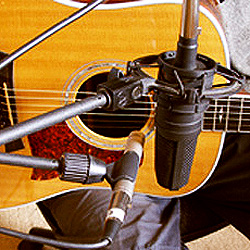Tracking guitar can be extremely tricky even under the most perfect of circumstances. And not every session is ideal. In reality, they’re often far from it.
So here are a few tips to keep in mind when you’re tackling that next guitar session.
1) Guitar Selection
Every brand and style of guitar has a different sound—Yamaha versus Martin, a full size Dreadnought or a smaller Parlor style. They all sound different, and an artist’s favorite or most expensive guitar may not be the best for every situation.
You may not be able to have a say in instrument selection, but having a few choices available will make it easier to get a lot closer to the sound that’s right for any song.
2) Tuning and New strings
This is very simple yet often overlooked. Before an important recording session, make sure artists have recently changed the strings on their guitars. And before every take, make sure it’s perfectly tuned. If the player is using a capo, it’s something that requires compensation when tuning.
3) Listening
Instead of just putting the mic where you think it will sound good, actually get up and walk around and listen to the tonal changes in each part of the guitar. When you find a favorite spot, put your mic there. This is a great starting point for a mono (single mic) recording as well as a good warm-up for your ears.
If the song calls for a stereo acoustic guitar part, you still need to find the sweet spot for the mics. How high or low, close or far—you won’t know until you take the time to listen.
4) Mic Choices & Positioning
In the studio it’s unlikely you’ll prefer the sound of a dynamic mic on acoustic guitar compared to a condenser. However, if you’ve never heard it, by all means try it. In fact, if you have the time, try all of your mics.
Large and small diaphragm condensers are the most common choices for acoustic guitar recording. Again, listen to the differences between mics and where you place them.
The closer the mic is to the instrument the more proximity effect (an exaggerated low frequency boost in the mic) there will be.
Avoid using mics that might exaggerate lows, mids or highs in an already too dark, middy or bright guitar. Pick a mic that complements or balances the sound; for example, a dark-sounding mic on an overly bright guitar.
5) Processing
After you’ve done your best to capture the guitar, you still may need to do some work to make it sit well within the mix with all the instruments. It’s not at all uncommon to need a bit of processing to make room for other instruments, as well as to control dynamics.
No matter how good a job you did in recording the instrument, be prepared to cut the very low frequencies, shape the mids to make room for vocals, compress a few dB to even out the performance and add a little reverb to give it space.
Jon Tidey is a Producer/Engineer who runs his own studio, EPIC Sounds, and enjoys writing about audio on his blog AudioGeekZine.com.





















